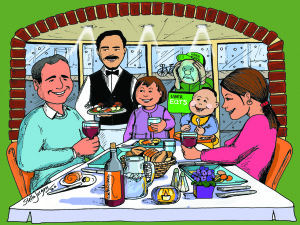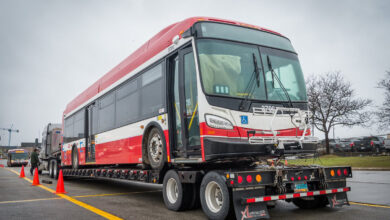O Winterlicious chegou para mais um ano na grande cidade de Toronto. De 31 de janeiro a 13 de fevereiro, milhares de apreciadores de comida irão visitar mais de 200 restaurantes para experimentarem uma grande variedade de iguarias culinárias, representantes da maioria das regiões do mundo. Será o Winterlicious financeiramente positivo para estes estabelecimentos? Possivelmente não, e a edição desta semana do Milénio tentará mostrar-lhe o perigo de ser proprietário de um restaurante que, em muitos casos, pode conduzir à ruína financeira.
Existe um provérbio que diz: “Gerir um restaurante era o teu sonho, estava destinado, mas quando o sonho finalmente se concretiza parece mais um pesadelo.”
Gerir um restaurante é um trabalho árduo. No primeiro ano, o fracasso dos restaurantes ronda os 60% e 80% dos restaurantes não passa a marca dos quatro anos. Com base nestas taxas de insucesso, porque é que alguém quer entrar no negócio da restauração? As longas horas, a falta de sono, ter de lidar com fornecedores, com os chefes egomaníacos e com os funcionários de serviço que, na sua maioria, odeiam os seus trabalhos e mudam mais de localização de trabalho do que alguns mudam de roupa interior, retrata a receita para o fracasso.
Então, se conseguir sobreviver o primeiro ano, o que transforma o restaurante num sucesso? Simplesmente, as boas práticas de negócio e um excelente atendimento ao público, o que a maioria dos estabelecimentos ignora em prol da estética, da falta de controlo e de resultados. Para a maioria, um restaurante é uma segunda casa onde os aspetos sociais das suas vidas podem concretizar-se através da comida, da bebida e da conversa e, por isso, a criação de uma atmosfera acolhedora é essencial para que os “membros da família” regressem. A palavra restaurante deriva do verbo francês “restaurer” o que significa “restaurar”, “fazer renascer”. Estas palavras significam que os restaurantes têm uma enorme responsabilidade para com os seus clientes na garantia de que as suas expectativas são cumpridas.
Além dos problemas acima mencionados, pode ainda questionar-se porque é que tantos restaurantes fecham. Existem múltiplos fatores que contribuem para o encerramento de um restaurante, incluindo o fraco controlo do inventário, o custo dos alimentos, um marketing fraco e pouco envolvimento com a comunidade. O poder da internet através das redes sociais, das avaliações dos restaurantes e de clientes ignorantes podem causar estragos num restaurante, onde uma critica pode resultar no encerramento. As publicações nas redes sociais de clientes que não se dão ao trabalho de se informar sobre o conceito do estabelecimento que pretendem visitar, que aparecerem de chinelos em restaurantes high end, sem saberem a diferença entre um hambúrguer do McDonald’s e um bife Kobi têm, no entanto, a capacidade de pressionar o botão de denegrir o estabelecimento que os serviu com classe, numa mesa de linho branco. Ou aqueles que sentem que pedir álcool é contra a sua religião e apenas pedem água com limão. Os restaurantes sobrevivem das vendas de álcool, água e café. Especialmente se os ingredientes forem frescos, a comida não dá lucro. Conheça o estabelecimento e o propósito da sua visita a um determinado restaurante. Se a sua intenção for apenas satisfazer a gula, então vá a um buffet onde pode comer excessivamente.
A multiplicação de empresas de entrega de comida tem tido um impacto negativo profundo em muitos restaurantes, particularmente naqueles que escolhem não participar de forma a manterem os seus padrões de qualidade elevados. Estima-se que o negócio diminuiu 30% e espera-se que esse número continue a aumentar. São várias as empresas que, tal como o Uber Eats, têm criado uma geração de millennials preguiçosos e outros que não conseguem levantar-se para ir buscar um café – preferem que lhes seja entregue. A sociedade está a funcionar com atitudes onde a conveniência irá destruir o conceito de trabalho e a servidão pelos outros torna-se a norma. Os ciclistas que fazem entregas invadem as ruas mais movimentadas, os passeios e etc. Olhando para os telemóveis sem respeito pelo trânsito, convencem o John Tory de que precisamos de mais faixas para ciclistas para que seja feita a entrega de comida para uma população preguiçosa incapaz de ser autossuficiente e que depois se queixa que não consegue suportar os valores da renda.
Entretanto, numa indústria que luta para se manter à tona, as empresas de entrega de comida irão custar-nos milhares de postos de trabalho devido ao encerramento dos restaurantes.
Sim, aproveite o Winterlicious e os restaurantes durante todo o ano, mas tenha consideração e respeito pelo investimento feito para que fosse possível abrir portas e recebê-lo como se fosse família.
Aproveite!

Editorial in english
Flor or Foodora
Winterlicious has arrived for another year in the great city of Toronto and from the 31st of January to February 13th, thousands of foodies will be visiting over 200 restaurants to sample a variety of culinary delicacies representing most regions of the world. Restaurants participate in this annual event plus Summerlicious in July to generate interest in their particular cuisine and promote businesses at the slowest times of the year. Is Winterlicious financially positive for these establishments? Possibly not and an attempt will be made by this week’s Milenio to show the perils of owning a restaurant which in many instances can lead to financial ruin.
There is a saying – “Running a restaurant was your dream, which was meant to be, but when the dream finally came true it felt more like a nightmare”.
Running a restaurant is hard work. Restaurants failure is about 60% in the first year and 80% of restaurants do not make it pastfour years. Based on these failure rates why the hell does anyone want to get in business of running a restaurant? Long hours, lack of sleep, dealing with suppliers, egomaniac chefs and service personnel who for the most part hate their job and change locations more often than some change underwear, combine to make it a recipe for failure.
So, what makes a restaurant a success if it hasn’t failed in the first years? Simply good business practices and excellent customer service which most failed establishments ignore in favour of aesthetics, lack of controls and the bottom line. For most, a restaurant is second home where the social aspects of their lives can be realized through food, drink and conversation, therefore the creation of an accommodating atmosphere is essential to get the return of “family members”. The word restaurant derives from the French verb “restaurer” meaning to “restore”, “to revive”. These words mean that restaurants have a huge responsibility to their clients to ensure that their expectations are fully met.
You may ask why such a high number of restaurants close in addition to previously mentioned issues? There are multiple factors that play into a restaurant closure, including poor inventory control, food costing, lack of marketing and community engagement. The power of the internet through social media, restaurant reviewers and uneducated clients play havoc with restaurants where a bad review can result in a restaurant closure. Social media postings by clients who do not bother to educate themselves on the concept of the place they intend to visit, and show up in flip flops to a high end establishment and cannot tell the difference between a McDonald’s hamburger and a Kobi beef have the ability to press a button to denigrate the place that served them with class in a white linen table. Or those who feel that ordering alcohol is against their religion and only order water with lemon. Restaurants survive on sales of alcohol, water and coffee. Food is not profitable particularly if fresh quality ingredients are used. Know the place and for what purpose you intend to go to a particular restaurant. If your intention is only to fill your gut, then go to a buffet and pig out.
The proliferation of food delivery has had a profound negative financial impact in many restaurants, particularly those who choose not to participate in order to maintain high quality standards. It is estimated that business has decreased about 30% and it’s expected to increase further. The many delivery companies such as Uber Eats and others have created a generation of lazy millennials and others who can’t get off their derriere to pick up a coffee and would rather have it delivered. Society is working with attitudes where convenience will destroy the concept of work and servitude by others will be the norm. The bicycle riding deliverers bombing down busy streets, sidewalks, etc. looking at their phones without any respect for other traffic will convince John Tory that more bicycle lanes are needed to make food deliverers to a lazy population incapable of self-sufficiency and then complain they can’t afford rent.
In the meantime, food deliveries will cost thousands of jobs due to restaurant closures in an industry struggling to keep afloat.
Yes, enjoy Winterlicious and restaurants the whole year but do it with consideration and respect for the investment made to open the doors to welcome as family.
Cheers!
Manuel DaCosta








Redes Sociais - Comentários